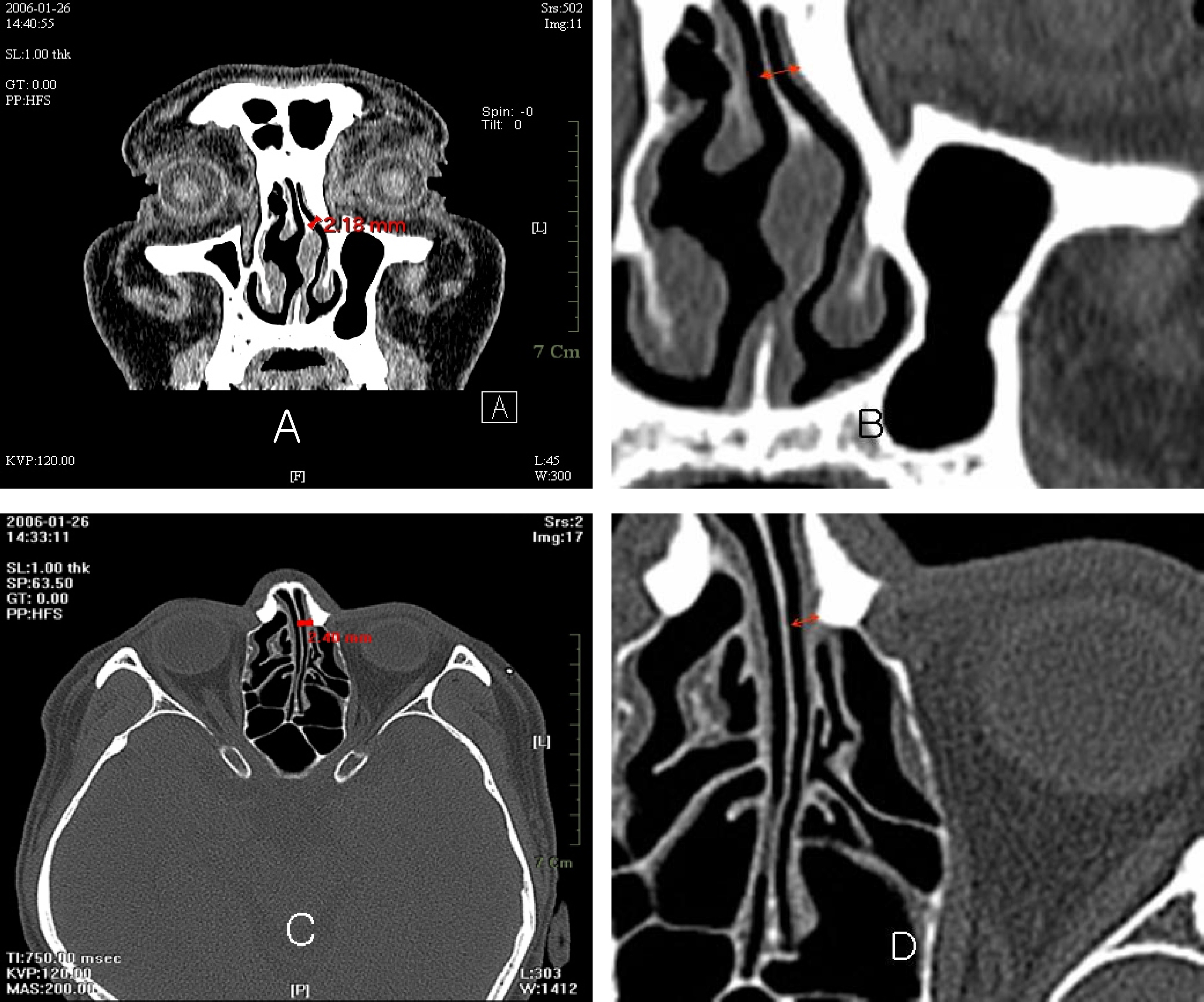J Korean Ophthalmol Soc.
2008 May;49(5):713-720. 10.3341/jkos.2008.49.5.713.
Clinical Outcome of Dacryocystorhinostomy with Septal Deviation
- Affiliations
-
- 1Department of Ophthalmology, College of Medicine, Hanyang University, Gyunggi, Korea. lyjot@hanyang.ac.kr
- 2Department of Otolaryngology Head and Neck Surgery, College of Medicine, Hanyang University, Gyunggi, Korea.
- KMID: 2211699
- DOI: http://doi.org/10.3341/jkos.2008.49.5.713
Abstract
-
PURPOSE: Septal deviation has few subjective symptoms. However, a difficulty remains in doing DCR (dacryocystorhinostomy) in these patients. We investigate the clinical course of DCR in patients with a septal deviation.
METHODS
Acquired nasolacrimal duct-obstructed patients who had undergone DCR with septal deviation from 2003 to 2006 in our hospital were retrospectively analyzed. We measured the septal distance using paranasal computed tomography taken preoperatively and compared the sex and age of patients, the kinds of operations, outcome of surgery, and ocular and nasal complications in our analysis.
RESULTS
Twenty-two eyes of 22 patients with a mean age of 55.3 years (range 29~74) were analyzed (4 males, 18 females). Mean septal distance was 4.84 mm (range 2.18~6.99 mm). Nineteen eyes had endonasal DCR, and three had external DCR. Two had DCR combined with septoplasty. Three had septoplasty as a secondary operation, Nasal complication was synechiae in 9 eyes. DCR success was seen in 15 eyes, and DCR failure in 7 eyes. Septal distance was not correlated with DCR success but was correlated with nasal complication (Mann-Whitney test, p=0.003)
CONCLUSIONS
In the case of DCR with septal deviation, the surgical technique used will need to minimize the mucosal injury and ensure appropriate nasal correction to prevent future complications.
Figure
Cited by 2 articles
-
Analysis of the Results Endonasal Dacryocystorhinostomy Related to Nasal Cavity State
Seung Kook Baek, Myung Sook Ha
J Korean Ophthalmol Soc. 2014;55(5):633-639. doi: 10.3341/jkos.2014.55.5.633.Surgical Outcomes of Endonasal Dacryocystorhinostomy According to the Level of Obstruction in Dacryocystography
Kyoung Hwa Bae, Nam Chun Cho, Min Ahn
J Korean Ophthalmol Soc. 2018;59(4):301-306. doi: 10.3341/jkos.2018.59.4.301.
Reference
-
References
1. Rice DH. Endoscopic intranasal dacryocystorhinostomy results in four patients. Arch Otolaryngol Head Neck Surg. 1990; 116:1061.
Article2. Mannor GE, Millman AL. The prognostic value of preoperative dacryocystography in endoscopic intranasal dacryocystorhinostomy. Am J Ophthalmol. 1992; 113:134–7.
Article3. Lim IS, Jeong SK, Park YG. A study of factors related to surgical success rate of dacryocystorhinostomy. J Korean Ophthalmol Soc. 1997; 38:1322–7.4. Lee HC, Chung WS. Success rate of endonasal dacryocystorhinostomy. J Korean Ophthalmol Soc. 1992; 37:211–8.5. Metson R. Endoscopic surgery for lacrimal obstruction. Otolaryngol Head Neck Surg. 1991; 104:473–9.
Article6. Park JD, Kim YI, Shin SG. The factor related to surgical success rate of endonasal dacryocystorhinostomy. J Korean Ophthalmol Soc. 1998; 12:39.7. Kim JM, Hong WP, Choi YJ, Kim SJ. The effect of nasal cavity abnormality related to surgical success rate of endonasal dacryocystorhinostomy. J Korean Ophthalmol Soc. 2006; 47:1233–7.8. Lee DP, Yang SW, Choi WC. The relation between nasal cavity size and success rate in endonasal dacryocystorhinostomy. J Korean Ophthalmol Soc. 2000; 41:1118–23.9. Lee JJ, Woo KI, Kim YD. Middle turbinectomy during dacryocystorhinostomy. J Korean Ophthalmol Soc. 1997; 38:710–4.10. Iliff CE. A simplified dacryocystorhinostomy. 1954-1970. Arch Ophthalmol. 1971; 85:586–91.11. Bumsted RM, Linberg JV, Anderson RL, Barreras R. External dacryocytorhinostomy. A prospective study comparing the size of the operative and healed ostium. Arch Otolaryngol. 1982; 108:407–10.12. Linberg JV, Anderson RL, Bumsted RM, Barreras R. Study of intranasal ostium external dacryocystorhinostomy. Arch Ophthalmol. 1982; 100:1758–62.
Article13. Welham RA, Wulc AE. Management of unsuccessful lacrimal surgery. Br J Ophthalmol. 1987; 71:152–7.
Article14. Allen KM, Berlin AJ, Levine HL. Intranasal endoscopic analysis of dacryocystorhinostomy failure. Ophthal Plast Reconstr Surg. 1988; 4:143–5.15. Woog JJ, Metson R, Puliafito CA. Homium:YAG endonasal laser dacryocystorhinostomy. Am J Ophthalmol. 1993; 116:1–10.16. Kong YT, Kim TI, Kong BW. A report of 131 cases of endoscopic laser lacrimal surgery Ophthalmology. 1994; 101:1793–800.17. Javate RM, Campomanes BS Jr, Co ND, et al. The endoscope and the radiofrequency unit in DCR surgery. Ophthalm Plast Reconstr Surg. 1995; 11:54–8.
Article18. Grymer LF, Hilberg O, Elbrond E, Pedersen OF. Acoustic rhinometry: Evaluation of the nasal cavity with septal deviations, before and after septoplasty. Laryngoscope. 1989; 99:1180–7.19. Giels WC, Gross CW, Abram AC, et al. Endoscopic septoplasty. Laryngoscope. 1994; 104:1507–9.20. Arbour P, Kern EB. Paradoxical nasal obstruction. Can J Otolaryngol. 1975; 4:333–8.21. Olsen KD, Kern EB, Westbrook PR. Sleep and breathing disturbance secondary to nasal obstruction. Otolaryngol Head Neck Surg. 1981; 89:804–10.
Article
- Full Text Links
- Actions
-
Cited
- CITED
-
- Close
- Share
- Similar articles
-
- The Effect of Nasal Septal Deviation and Septoplasty on Dacryocystorhinostomy Progression
- Correction of Caudal Septal Deviation: Septal Batten Graft with a Bioabsorbable Plate
- Effectiveness of Washing Nasolacrimal Duct as an Additional Therapy after Dacryocystorhinostomy
- The Effect of Dacryocystorhinostomy and Septoplasty Combination Surgery for Lacrimal Obstruction with Septal Deviation
- Structural Changes of Inferior Turbinate in Patients with Septal Deviation: Surgical Implication




